新版pep小学英语四年级下册unit4_A_Let's_talk公开课
pep(人教)四年级英语下册 Unit 4 A Let's talk教案.doc
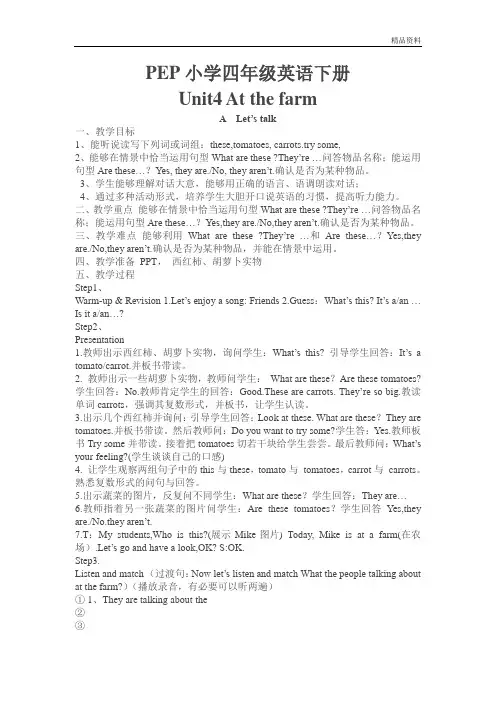
PEP小学四年级英语下册Unit4 At the farmA Let’s talk一、教学目标1、能听说读写下列词或词组:these,tomatoes, carrots.try some,2、能够在情景中恰当运用句型What are these ?They’re …问答物品名称;能运用句型Are these…?Yes, they are./No, they aren’t.确认是否为某种物品。
3、学生能够理解对话大意,能够用正确的语言、语调朗读对话;4、通过多种活动形式,培养学生大胆开口说英语的习惯,提高听力能力。
二、教学重点能够在情景中恰当运用句型What are these ?They’re …问答物品名称;能运用句型Are these…?Yes,they are./No,they aren’t.确认是否为某种物品。
三、教学难点能够利用What are these ?They’re …和Are these…?Yes,they are./No,they aren’t.确认是否为某种物品,并能在情景中运用。
四、教学准备PPT,西红柿、胡萝卜实物五、教学过程Step1、Warm-up & Revision 1.Let’s enjoy a song: Friends 2.Gu ess:What’s this? It’s a/an … Is it a/an…?Step2、Presentation1.教师出示西红柿、胡萝卜实物,询问学生:What’s this? 引导学生回答:It’s a tomato/carrot.并板书带读。
2. 教师出示一些胡萝卜实物,教师问学生:What are these?Are these tomatoes?学生回答:No.教师肯定学生的回答:Good.These are carrots. They’re so big.教读单词carrots,强调其复数形式,并板书,让学生认读。
PEP小学英语四年级下册_第四单元_PART-A__Lets__talk_教学设计

PEP小学英语四年级下册第四单元PART-A 第二课时教学设计教学目标:能听懂会说“Can I wear my…”,并能在适当情景中运用。
在对话中复习服装类单词,巩固描述天气的单词cold,warm,cool,hot。
教学重点:能够正确运用Can I wear my…?Yes, you can./No, you can’t.教学重点:Can I wear my…?It’s warm today. You can wear your new shirt.教学过程:Good morning!Boys and girls!What time is it?...It’s time for English class.Are you ready?一、Warm-up(热身)说歌谣:Let’s chant.师播放课件:Let’s chant,师生齐说歌谣:Mmm,It’s cool today! Take off your jacket!…通过说歌谣,不仅可以调动学生的学习积极性,同时也复习了天气类和服装类的单词。
二、Revision&Preview(复习&预习)1、根据服装猜天气。
教师首先用课件演示,出示一张中国地图,上面注明哈尔滨、北京等具有代表性的城市,并用高亮显示。
点击任意一个城市,则出示穿着不同服装的人物,让学生根据人物的穿着,猜当地的天气,用上节课的It’s warm/cool…来回答。
2、教师继续运用地图课件模拟演示天气预报:Good moring.This is the weather report…,所不同的是当每点击一个城市,则会出现当地的天气状况的提示。
然后再请同学运用课件模拟天气预报。
三、Presentation(新课呈现)同学们,现在我们已了解了祖国部分城市的天气状况,那么今天我们居住的城市又是怎么样呢?(What’s the weather like in Huadian ?)学生可根据天气状况回答。
人教版pep英语四年级下册Unit 4 A Let’s talk名师课件
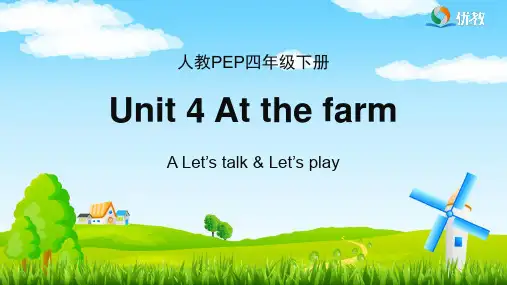
>>Practice
Man: They’re tomatoes. Mike: Bu(t) they’re yellow! Man: Try some! They’re good. Mike: Thanks. Yum.
>>Practice
分组分角 色齐读;
在小组内 进行分角 色朗读, 每读完一 遍,交换
Are these ...?
Yes, they are.
What are these? They are ...
Summary
1. 登录“优教同步学习网”,朗读对话。 2. 仿照课文对话,编一段新对话,下节课表演。 3. 登录“优教同步学习网”,预习A Let’s learn中的单词。
感情与肢体语言丰富。
>>Practice
Let’s play
>>Practice
Make a talk
>>Practice
打开U4 A Let’s talk课堂 基础练/拔高练,即学即 练,检测当堂学习情况。
Summary
tomatoes
carrots
Are these ...?Yes, they are. What are these?They are....
>>Presentation
What colour are the tomatoes?
What colour are the carrots?
>>Presentation
this tomato
these tomatoes
>>Presentation
this carrot these carrots
小学英语四年级下册《Unit4Atthefarm(PartALet'stalk)》说课稿
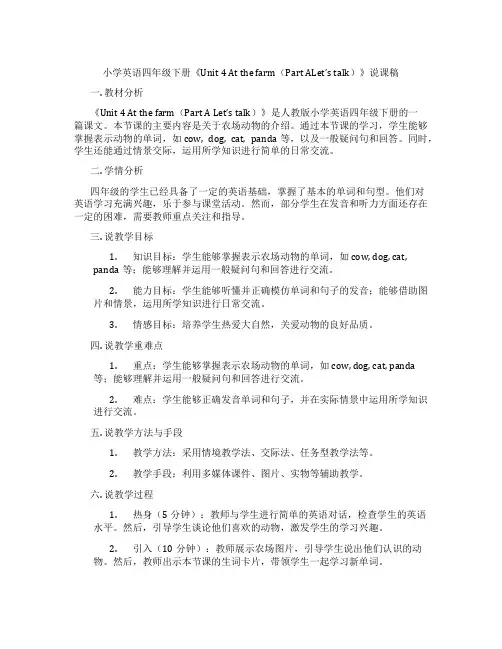
小学英语四年级下册《Unit 4 At the farm(Part ALet’s talk)》说课稿一. 教材分析《Unit 4 At the farm(Part A Let’s talk)》是人教版小学英语四年级下册的一篇课文。
本节课的主要内容是关于农场动物的介绍。
通过本节课的学习,学生能够掌握表示动物的单词,如cow, dog, cat, panda等,以及一般疑问句和回答。
同时,学生还能通过情景交际,运用所学知识进行简单的日常交流。
二. 学情分析四年级的学生已经具备了一定的英语基础,掌握了基本的单词和句型。
他们对英语学习充满兴趣,乐于参与课堂活动。
然而,部分学生在发音和听力方面还存在一定的困难,需要教师重点关注和指导。
三. 说教学目标1.知识目标:学生能够掌握表示农场动物的单词,如cow, dog, cat,panda等;能够理解并运用一般疑问句和回答进行交流。
2.能力目标:学生能够听懂并正确模仿单词和句子的发音;能够借助图片和情景,运用所学知识进行日常交流。
3.情感目标:培养学生热爱大自然,关爱动物的良好品质。
四. 说教学重难点1.重点:学生能够掌握表示农场动物的单词,如cow, dog, cat, panda等;能够理解并运用一般疑问句和回答进行交流。
2.难点:学生能够正确发音单词和句子,并在实际情景中运用所学知识进行交流。
五. 说教学方法与手段1.教学方法:采用情境教学法、交际法、任务型教学法等。
2.教学手段:利用多媒体课件、图片、实物等辅助教学。
六. 说教学过程1.热身(5分钟):教师与学生进行简单的英语对话,检查学生的英语水平。
然后,引导学生谈论他们喜欢的动物,激发学生的学习兴趣。
2.引入(10分钟):教师展示农场图片,引导学生说出他们认识的动物。
然后,教师出示本节课的生词卡片,带领学生一起学习新单词。
3.新课呈现(15分钟):教师播放课件,展示农场动物的视频,引导学生跟读并模仿发音。
Unit4_A_Let’s_talk课件
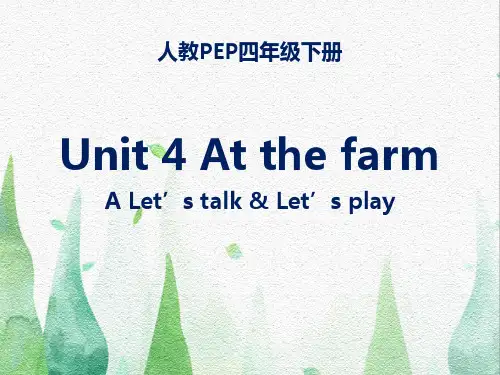
Are these carrots? What are these? Try some!They're good.
Summary
tomatoes
carrots
Are these ...?Yes, the....
人教PEP四年级下册
Unit 4 At the farm
A Let’s talk & Let’s play
>>FWraerme-utpalk
How many kinds of animals on his farm?
>>LLeeaadd-inin
Young Mcdonald has a farm,too.
A: Are these tomatoes? B: _Y_e_s_,t_h_ey__ar_e_. __.
>>Presentation
-Are these tomatoes? -No,they aren't. -What are these? -They are carrots.
>>Presentation
Are these ...?
Yes, they are.
What are these? They are ...
Homework
1.Read the dialogue 5 times,pay attention to the pronunciation and intonation. 2.Design your own farm,make a new dialogue using the key sentences we have learnt today.
小学四年级英语《Unit 4 My home A Let’s talk》公开课教案
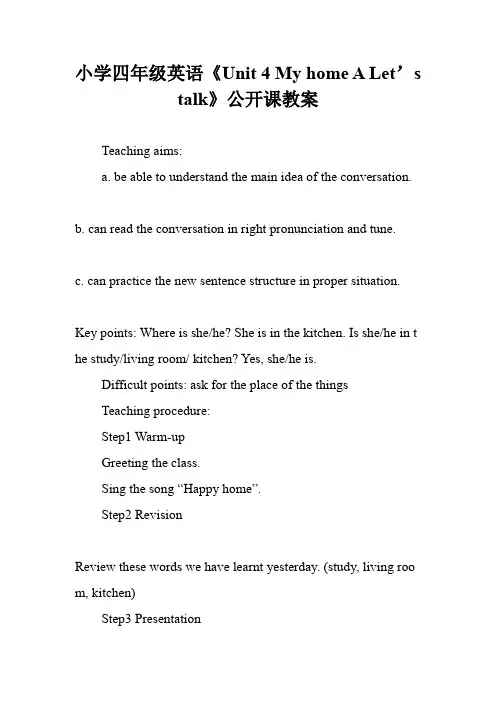
小学四年级英语《Unit 4 My home A Let’stalk》公开课教案Teaching aims:a. be able to understand the main idea of the conversation.b. can read the conversation in right pronunciation and tune.c. can practice the new sentence structure in proper situation.Key points: Where is she/he? She is in the kitchen. Is she/he in t he study/living room/ kitchen? Yes, she/he is.Difficult points: ask for the place of the thingsTeaching procedure:Step1 Warm-upGreeting the class.Sing the song “Happy home”.Step2 RevisionReview these words we have learnt yesterday. (study, living roo m, kitchen)Step3 PresentationLet’s look at the picture.T: Who is she? Who is that girl?S: She is Amy/Sarah.T: What are they doing?S: They are talking about the cat.Now let’s talking unit 4 My home let’s talk. (Write the topic on the blackboard)T: Look at the picture. Where is the cat? Is it in the study/ living room/ kitchen?S: Yes, she/he is. No, she/he isn’t.read the conversation by themselves.some students to read the conversation and then read it afte r the radio.its Chinese meaning.Step 4 Practiceplay.a game. (Hide and seek)Step 5 Consolidationa. Complete the conversation.I have a cat. _________where is she? Mmm, _________No, she isn’t.Is she in the study?No, _________Look! _________b. Multiple-choice.Is this your kitchen? is in the living room.Is your mother in your bedroom? B. Yes, it is.Where is your father? No, she isn’t.Step 6 Summary-Where is she?-She is in the kitchen.Is she/he in the study/living room/kitchen?Yes, she/he is.No, she/he isn’t.Step 7 Homeworka picture of your family.up a dialogue and practice it with your deskmates accordin g to what we have learnt today.Step6 8 Blackboard designUnit 4 My home A Let’s talkWhere is she/he?She is in the kitchen.Is she/he in the study/living room/ kitchen?Yes, she/he is.No, she/he isn’t.Step 7 ReflectionThis class goes on well. Most of the students can master the mai n ideas. A few students are too active to obey the rules. Next cla ss I will pay more attention to these students.。
pep(人教)四年级英语下册 Unit4__A__Let’s__talk教学课件
此句型可用于确认事物,是由be动词are 引导的一般疑问句。主语these是复数 形式。注意回答用they。
例子:Are these horses? No, they aren’t. They are donkeys.
Task4:完成对话
Let’s read together!
Sarah : Look at these! Are these carrots? Man : Yes, they are. Mike : Wow! They are so big! Mike : What are these? Man : They’re tomatoes. Mike : But they’re yellow! Man : Try some! They’re good. Mike : Thanks. Yum.
询问“这些/哪些是什么?”的句型及答 语—What are these/those? They are… 句型结构 问句 What are these/those? 答语 They’re+事物名称。
此句型可用于询问事物的名称,是由 what引导的特殊疑问句。 these/those用来指代复数名词,所以 be动词用are, these用于指代近处的事 物,those用于指代远处的事物。
容创编新对话。
(你可以根据自己的实际情况任选一个做)
有古
一人
个云
在:
路“
上读
。万
”卷
从书
古,
至行
今万
,里
学路
习。
和”
旅今
行人
都说
是:
相“
辅要
相么
You made my day!
成读 的书
小学英语《Unit 4 My home Part A Let's talk》优质课教学设计、教案
体 验 阅 读 的 乐 趣 ; 学 生 能 够 体 会 到 在 教 室 里 要 保持安静、注意安全。
学 生 能 够 初 步 感 知 听读技巧, 感 知 搜 寻 关 键 信 息 的能力。
学生了解中西方家庭文化的不同。
教学过程
Warming up
明确目标
导入主题
T:Let’s sing asong.OK?
Step III
Let’s students watch the video and discuss.
T: What’s that?
Is it cute?
Ss:It’s a ......
Yes, it is.
Animals are
Emotion
so cute and
education
friendly, so
Is it in the
living
room?
No, it isn’t.
能在实际情
景中运用.
第二课时
A.Let’slearn Let’sdo
能听懂、会说1、.认读本课词汇bedroom,
living room,bathroom,
study,2
kitchen
能够使用本课时句式Whereis it? Itisin...问答
。
第三课时
A Let’s spell
能够根据u与u-e的发音规律拼写单词。
能在发音规则的指导下听音写出词汇。
学生能在掌握语音规律的过程中体会成就感,强化学习动机,提高学生学习语音的兴趣
并能举一反三将规律运用到生词的试读中
、Байду номын сангаас
。
B.Let’s talk
能听懂、会说句 型 :Arethey on
最新PEP人教英语四年级下册unit 4 A lets talk公开课课件
C B
C
选择:
(B )1.What are these? A: Yes they are. (C )2.Is this a tomatoes? B: They are potatoes? (A )3.Are these carrots? C: Yes ,it is. ( )4.How many tomatoes do you have? D: DThree.
.
What are these?….
Let’s talk
根据课文内容,回答问题:
• How many vegetables can you see? • What colour are the tomatoes?
根据课文内容,回答问题:
Are these…? Yes,they are./ No, they aren’t.
选择
• • • • • • • • • • 1.What are they? are B tomatoes. A: There B: They C: It 2.Can you see the green beans ?Yes, I ____. A: am B: do C: can 3.How many carrots can you see? I can see _____. A: red B: three C: long 4.Look at the farm. big. A: It’s B: They’re C: I ‘m A 5.I like . A: potatos B: potato C: potatoes
• How many vegetables can you see?
Two. • What colour are the tomatoes? They’re yellow.
新人教版(PEP)四年级英语下册Unit4 At the farmm Part B Let’s talk公开课课件
自学指导一:
打开P41、听录音,然后回答问题: (答案写在小黑板)
每题可得1个动物
1 . What are those ?
They are horses. Seventeen.
2 . How many horses do you have? 3 .Are they hens? What are those?
How many animals do you have?
数一数你们今天得了多少个动物。
设计你们的农场吧! 你们想拥有自己的农场吗?
动物是我们人类的好朋友!
1.What are those? They are … 2.Are they …? Yes ,they are. No ,they aren’t.
Are they sheep?
No , they aren’t. They are rabbits.
Are they tigers?
No , they aren’t. They are cats.
What’s that?
It’s a cat.
What are those?
那些是什么?
They are cats.
They're horses.
What about those? Are they hens?
Cool! How many horses do you have?
Mmm...Seventeen.
No, they aren't. They're ducks.
你来说说
Wow! You have a lot of _______animals! What are those?
对话练习:一名同学问,其他同学回答,轮流练习。
- 1、下载文档前请自行甄别文档内容的完整性,平台不提供额外的编辑、内容补充、找答案等附加服务。
- 2、"仅部分预览"的文档,不可在线预览部分如存在完整性等问题,可反馈申请退款(可完整预览的文档不适用该条件!)。
- 3、如文档侵犯您的权益,请联系客服反馈,我们会尽快为您处理(人工客服工作时间:9:00-18:30)。
Number 1、What are these? 2、 Look at these. Are these carrots? 3、They’re tomatoes. 4、Wow!They’re so big! 5、Try some!They’re good. 6、Yes,they are. 7、Thanks,yum. 8、But,they’re yellow. (2 )( 6)(4)(1 )(3 )(8)(5 )( 7)
A: What are these? B: They’re_____. A: But they are_____. B: Try some! They are good. A: Thanks. Yum.
根据所给提示创编对话
A: Look at these. Are these _____? B: Yes, they are. A: Wow! They are so ______. A: What are these? B: They’re_____. A: But they are so____. B: They are tea cup dogs. (茶杯犬)
What are these?
They are bananas.
What are these? They are carrots.
What are these? They are tomatoes
.
Guess: What are these?
1
2
3
根据所给提示创编对话
A: Look at these. Are these _____? B: Yes, they are. A: Wow! They are so ______.
Ut’s talk
1. ---What is this ? ---It’s an apple. 2.---What are these? ---They are apples.
1. ---What is this ? ---It’s a carrot. 2.---What are these? ---They are carrots.
选择:
• • • • • • • • 1.Are these carrots? (D ) A:它们很好吃。 2.Look at these ! ( E) B:它们如此大。 3.They are so big. (B ) C: 但是它们是黄色的 4.What are these ? ( F ) D: 这些是胡萝卜吗? 5.They’re tomatoes. (G ) E:请看这些。 6.Try some. ( H) F:这些是什么? 7.They are good. ( A) G: 它们是西红柿。 8.But they are yellow. ( C ) H: 试吃一些。
选择:
( B )1.What are these?
( C )2.Is this a tomato? ( A)3.Are these carrots? ( D)4.How many tomatoes do you have? D:Three.
A:Yes they are. B:They are potatoes. C:Yes ,it is.
Vegetables and fruits are healthy food. They are green food. We should eat more.
Tank you! Good bye!
